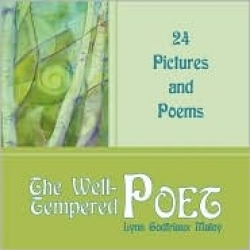The Well-Tempered Poet
24 Pictures and Poems
Poets as disparate as Elizabeth Barrett Browning, Charles Baudelaire, and Thomas Moore have put pen to paper to write about music. Music is accepted as a universal language to which we all respond, and poetry’s oral tradition speaks to us in similar ways. Despite that connection, some people have trouble understanding the deeper meaning in works of music or poetry. Poets who choose to write about music accept the challenge of making the abstract nature of both mediums more comprehensible.
Lynn Godfriaux Maloy, a musician and writer, presents readers with twenty-four poems about music in her collection, The Well-Tempered Poet. She writes about the differences in sound clarity between analog and digital recordings, feelings of frustration about the fickle nature of creative inspiration, admiration for the musical genius of Beethoven, discouragement about negative music criticism, and triumph over pre-performance nervousness. The poems are written in four-line, rhymed stanzas or free verse of varying line structure. Maloy’s own music-related photographs and original watercolor and pastel chalk art by Evelyn Brenner illustrate and illuminate this brief book.
The author studied music at Oklahoma University, earning a master of arts degree in piano performance. Maloy has performed and taught music professionally for the past twenty years. She also writes suspense novels.
In her poem about listening, she urges readers to be aware of the transference of sound from inanimate piano to notes on paper, and finally to the animated ten fingers that interpret the music they hear. The poem ends with these lines:
Listen…
Listen…
to ghosts who dance upon tight-rope strings
as through concrete physics they express abstract wings.
Accomplished musicians must practice endless hours to perfect their art and maintain fluency of expression. As with any routine effort, a pianist tires of practicing. In “Practice Companion,” Maloy imagines a furry rabbit dancing to the music she plays.
Then, his gentle eyes winking at me with light-hearted humor,
he hopped back and disappeared into the strings.
I really did not want to practice; but, resigned, I tried again…
and to my delight discovered that he had fixed things
Having devoted her life to classical music, the author decides to explore the more popular musical forms that her friends prefer. She attends a “metallic rock concert,” without knowing anything about that type of music. Her conclusion:
So now, whenever I talk about music with another,
I keep my comments minimum and nod my head.
I have secretly vowed that for my next rock concert,
I will be buying a Rachmaninoff ticket instead!
Maloy writes from her heart and effectively conveys her passion for music. Her choice of words can seem awkward in some instances, and a few of the poems are so adorned with modifiers as to obscure meaning. In other phrases, she reveals the inspired combination of words that make poetry beautiful.
Poetry lovers who recognize the difficulties inherent in writing poetry about music will especially appreciate this collection. The accompanying illustrations contribute significantly to the book’s appeal.
Reviewed by
Margaret Cullison
Disclosure: This article is not an endorsement, but a review. The publisher of this book provided free copies of the book and paid a small fee to have their book reviewed by a professional reviewer. Foreword Reviews and Clarion Reviews make no guarantee that the publisher will receive a positive review. Foreword Magazine, Inc. is disclosing this in accordance with the Federal Trade Commission’s 16 CFR, Part 255.

